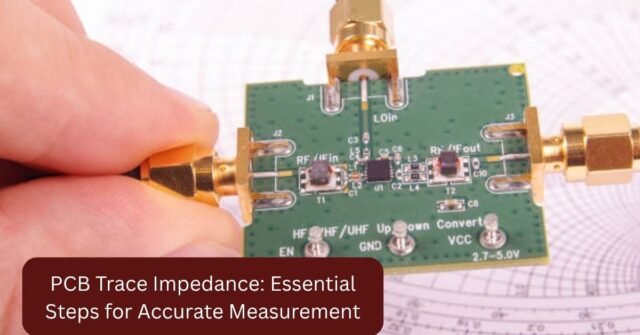In the ever-evolving field of electronics, maintaining signal integrity is crucial, especially in high-frequency applications. As circuit complexity increases, trace impedance becomes a key factor in reliable signal transmission. For any advanced PCB design service, understanding and measuring PCB trace impedance is no longer optional it’s an essential skill. As technology pushes toward faster, denser, and more energy-efficient designs, impedance control helps prevent signal distortion, reflection, and data loss.
This article explores the critical steps involved in measuring PCB trace impedance, highlights why it matters, and provides best practices in alignment with 2025’s current trends in PCB layout and manufacturing.
What is PCB Trace Impedance?
PCB trace impedance is the total opposition that a circuit trace presents to the flow of alternating current. Unlike simple resistance, impedance includes the effects of capacitance and inductance, which become especially relevant at high frequencies.
When signals travel along a PCB trace, variations in impedance can cause reflections and degrade signal quality. Therefore, ensuring that trace impedance remains consistent and matches the source and load impedance is vital for signal fidelity.
Why Accurate Impedance Measurement is Critical
For high-speed digital and RF designs, uncontrolled impedance can lead to numerous issues, such as:
- Signal reflection and ringing
- Crosstalk between adjacent traces
- EMI/EMC compliance failures
- Reduced device performance or complete malfunction
To prevent these complications, designers must measure and control impedance early in the development process. Today, many PCB design service providers include impedance control as a default requirement in high-frequency circuit layouts.
Factors That Affect PCB Trace Impedance
Several variables contribute to impedance in a PCB trace:
- Trace width and thickness
- Dielectric constant of the substrate material
- Height of the trace above the reference plane
- Trace geometry (microstrip, stripline, coplanar waveguide)
- Solder mask presence
Each of these parameters must be factored into the impedance calculation or simulation. In 2025, tools have become smarter, but the fundamentals remain rooted in physics. Using these inputs, designers can predict impedance and adjust layouts accordingly.
Key Methods to Measure PCB Trace Impedance
The two most commonly used methods for measuring trace impedance are Time Domain Reflectometry (TDR) and Vector Network Analysis (VNA).
1. Time Domain Reflectometry (TDR)
TDR works by sending a fast-rise-time pulse down the trace and analyzing the reflected signal. If the trace has uniform impedance, there will be minimal reflection. However, if impedance changes (due to layout flaws or design issues), the reflected signal indicates the point and nature of the problem.
TDR is widely preferred because:
- It is non-destructive
- It provides high accuracy
- It can locate impedance mismatches along the trace
2. Vector Network Analysis (VNA)
VNA measures impedance by analyzing the frequency response of the circuit. It offers more detailed insights into impedance behavior across a range of frequencies but requires complex calibration and setup.
For modern PCB design service teams working with RF boards, combining TDR and VNA ensures both time-domain and frequency-domain accuracy.
Role of Simulation Before Fabrication
Before manufacturing, most professionals rely on impedance simulation tools integrated within EDA platforms. These tools use 2D or 3D field solvers to calculate impedance based on stack-up, trace geometry, and material properties.
Simulation offers:
- Cost-effective design adjustments
- Pre-fabrication verification
- Iteration-friendly process
Yet, simulation is just a starting point. Actual measurement post-fabrication confirms that manufacturing has adhered to the expected specifications.
Importance of Controlled Impedance PCBs
Controlled impedance PCBs are purpose-built to maintain uniform trace impedance throughout. They are critical for:
- USB, HDMI, SATA, and Ethernet interfaces
- RF communication devices
- High-speed microcontroller and FPGA circuits
For designers offering professional PCB design, specifying and validating controlled impedance in documentation is crucial to achieving consistent performance in the final product.
Practical Guide to Trace Impedance Measurement
For those seeking a hands-on approach to impedance measurement, this practical guide on how to measure PCB trace impedance breaks down the tools and techniques used in real-world scenarios. From setting up TDR equipment to interpreting results and correcting mismatches, the blog provides actionable insights for engineers, technicians, and hobbyists.
Understanding these real-time measurement techniques empowers design teams to validate their PCB layouts and stack-ups against simulations and specs, ensuring that signal integrity is maintained throughout the product lifecycle.
Tips for Maintaining Impedance Accuracy During PCB Design
To ensure your trace impedance remains consistent across all design stages:
1. Define the Stack-up Early
The dielectric material and thickness between layers affect impedance more than trace width alone. Finalize the stack-up during early design to avoid last-minute surprises.
2. Use Field Solvers
Avoid rule-of-thumb calculators in favor of field solvers, which consider complex geometry and material behavior.
3. Collaborate With Fabricators
Many PCB fabrication shops offer specific impedance tolerances. Collaborate closely to match your design rules with their manufacturing capabilities.
4. Maintain Consistent Trace Geometry
Avoid sudden changes in trace width, bends, or via stubs, which can cause impedance discontinuities.
5. Use Differential Pair Routing When Necessary
High-speed interfaces like USB and HDMI require differential routing. Ensure trace spacing and length matching are maintained to avoid skew and impedance mismatch.
Impedance Tuning: Post-Fabrication Adjustments
Sometimes, minor mismatches occur even after careful simulation. Designers may apply tuning techniques like:
- Adding termination resistors
- Adjusting trace length through serpentine routing
- Using impedance matching circuits (capacitors or inductors)
These corrections help improve real-world signal performance without major redesigns.
The Evolving Role of PCB Design Services in Impedance Control
In 2025, a modern PCB design service does more than layout; it involves signal integrity engineering, impedance modeling, and verification through both digital tools and physical measurements. As miniaturization continues and speeds increase, impedance control will play a pivotal role in achieving functionality across a wide range of industries—telecommunications, automotive, aerospace, and more.
Additionally, with rising trends in flexible PCBs, wearable devices, and IoT solutions, impedance control now extends to non-traditional substrates and geometries, demanding even more precise analysis.
Common Mistakes to Avoid
Even experienced engineers can fall into traps when dealing with trace impedance. Common pitfalls include:
- Relying solely on simulation and ignoring real-world measurements
- Using incorrect dielectric constant values
- Neglecting effects of vias or stubs
- Forgetting to update stack-up with material changes
- Ignoring solder mask’s influence on impedance
Avoiding these mistakes can significantly reduce design rework and manufacturing issues.
Final Thoughts: Toward Better Signal Integrity
In conclusion, accurate PCB trace impedance measurement is a cornerstone of high-performance circuit design. From simulation to real-time testing, every stage plays a role in ensuring clean, distortion-free signals. Whether you’re a solo designer or part of a professional PCB design service, embracing impedance best practices will set your projects apart in a competitive tech landscape.
With the industry pushing toward higher frequencies and more compact layouts, those who understand and control impedance effectively will lead the way in innovation and reliability.







